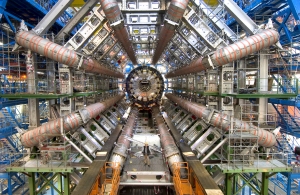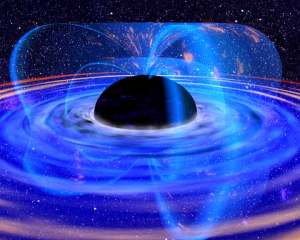Seven TRILLION electron volts! (7,000,000,000,000 eV) Or, 7 teraelectron volts. (7 TeV) Holy bug-zapper, Batman, that sounds like a lotta juice! If only we could bottle it, that would be one great “alternative” source of energy.
Hold on, cowboy! We’re talking electrons, here. You know how small those things are, right? Fact is, one mosquito buzzing around your head represents about 1 TeV of kinetic energy, so we’re looking at 7 flying mosquitoes’ worth of energy. Doesn’t sound like much, but it was enough to get scientists at the European Organization for Nuclear Research (CERN) all a-tizzy last month.
Some of you may remember that I posted a couple months ago about CERN’s Large Hadron Collider (LHC) on — actually, more than 570 ft. beneath — the French-Swiss border. Well, this was part of the experiments that particle physicists have been planning for the $9.4 billion particle accelerator. They were able to get two beams of protons up to 3.5 TeV each and ram them together! (Boys will be boys! Of course, there are girls involved, too, so, um,… nevermind.) A new world record for man-made particle collisions!
The 17-mile tunnel through which the collider loops is supercooled with liquid helium to just a couple degrees over absolute zero, making it “the coldest place in the universe”. There are two beam pipes that mostly run parallel, each containing a proton beam, which travel in opposite directions around the ring. More than 1600 powerful, superconducting magnets — recently repaired after electrical overheating caused major damage back in Sept. 2008 — keep the beams focused and “on track”, as it were. By altering the magnetic forces slightly, the two beams can be forced to cross at four intersection points and, hopefully, cause at least a few of the billions of protons to collide. Half a dozen detectors — two general purpose and four specialized — are set up at these points to, er, detect the various types of energy, forces, matter, & antimatter that are generated by the collisions.
Attempts earlier in the day experienced problems with the beams, so they had to “dump” the protons and inject fresh ones to create two new beams. But, on March 30 at 13:06 Central European Summer Time (CEST), the first successful collision was achieved, and scientists tuned in worldwide cheered enthusiastically.
“It’s a great day to be a particle physicist,” said CERN Director General Rolf Heuer. “A lot of people have waited a long time for this moment, but their patience and dedication is starting to pay dividends.”
Now, they can begin studying this latest batch of data from the somewhat-controversial LHC project. The hope is to start getting some answers about things such as the origins of the universe, the nature of matter-antimatter asymmetry, supersymmetry, maybe even the elusive “God particle” (aka Higgs boson). The previous record for similar attempts was 2.36 TeV, but it was insufficient to mimic the desired conditions from the moments following the Big Bang. (Next, they plan to double the output to 14 TeV! But, not before 2013.)
Nature does it all the time with cosmic rays (and with higher energy) but this is the first time this is done in Laboratory!” tweeted one scientist.
You may also remember from my earlier post that some people who heard of the planned experiments warned of the mini black holes that could be generated and the apocalyptic results. But, as you may have noticed, such fears were (so far) unfounded, because, well, we’re still here.
With these record-shattering collision energies, the LHC experiments are propelled into a vast region to explore, and the hunt begins for dark matter, new forces, new dimensions and the Higgs boson,” said ATLAS collaboration spokesperson, Fabiola Gianotti. “The fact that the experiments have published papers already on the basis of last year’s data bodes very well for this first physics run.”
Sounds very promising, and I’m intrigued by what exciting discoveries lie just over the horizon. (For more quotes and more info on the experiments scheduled, check out this ScienceDaily article and related ones.)


